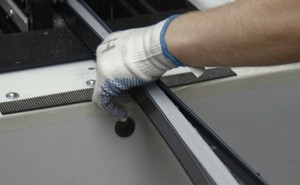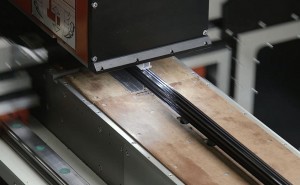To be able to guarantee your customers a pleasant indoor temperature both in winter and in summer; it’s what we all want! By installing thermal break window profiles we’re making a significant step in the right direction. The thermal barrier in those profiles may be created in different ways, for example with PVC.

PVC strip increases the insulating power of aluminium window profiles
PVC or polyvinyl chloride is a plastic which consists of 43% ethylene and 57% sodium chloride, better known as cooking salt. In order to make useful products from this basic mixture, additives are added to it. For smooth processing, for example, flow improvers are added and to improve light resistance, UV stabilizers.
Discovered by chance
The French physicist Henri Victor Regnault discovered PVC in 1838 purely by chance. His discovery then remained quiet for a long time. It was only in 1872 that German chemist Eugen Baumann succeeded in unravelling the secret of PVC production. At the beginning of the last century that produced concrete applications, but it was only after the Second World War that PVC grew to become the most popular of all plastics.
Nowadays, you come across PVC everywhere: in the automotive sector (e.g. dashboards, door panels), the food industry (as the ideal way of packing meat) and in the medical world (blood bags and catheters). Also in daily life you come across PVC every day – possibly unconsciously: your raincoat, your credit card, your kid’s inflatable beach toys, your shoes. They all contain PVC.
Most used plastic in construction
PVC is also the most used plastic in the building industry. In Western Europe, more than 65% of PVC produced has its final destination in this sector. The benefits are numerous: PVC is very light but at the same time strong, impact-resistant and resistant to wear, it is easy to work whereby the most complex designs are possible, it’s waterproof, resistant to chemicals, it is extremely durable owing to its high weather resistance and finally PVC may also be readily recycled. After the end of the already long service life (people sometimes speak of 100 years) the old PVC is reground into pellets, which form the basis for new PVC products.
One specific application of PVC is its use in window profiles. Of course PVC window profiles already exist, but this plastic, like polyamide and ABS may be used for strips that are placed in aluminium profiles to improve thermal insulation. Aluminium is not a good thermal insulator at all. The solution lies in positioning a thermal barrier between two aluminium extrusions. This thermal barrier consists of a strip of plastic that has excellent insulating properties. For example PVC. Because in addition to the benefits of PVC listed, combined with good acoustic insulation, this plastic also ensures that the temperature in your house stays pleasant throughout the year. And the fact that it means a decrease in your energy costs is something that consumers don’t mind at all!
- Peter De Roovere



Leave a comment